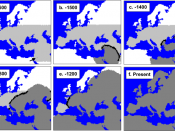Scientists believe that for the first time they have seen the faces of immediate ancestors of modern humans in fossilized skulls of two adults and three children over 160,000 years old. They are identifiable as modern humans excluding a few ancient characteristics. The contemporary or previous Neanderthals in Eurasia had shorter skulls. The new Ethiopian skulls have tall and narrow nasal bones, but their midfaces are broad. More primitive ancestors had more prominent brow ridges, and the Ethiopian skulls have higher more modern cranial vaults.
A major step in establishing the moment in time and place for the appearance of anatomically modern humans about 150,000 years ago in Africa, is this discovery of the oldest near-modern human remains.
A paleontologist from the University of California Berkley, Dr. Tim White, who is a leader of the international team that excavated and analyzed the skulls said, "We can now see what our direct ancestors looked like".
The interval in fossil evidence dated between 100,000 and 300,000 years ago is the supposed period of transition from prehuman to modern humans that before now it had been impossible to determine what our direct ancestors looked like.
The research appears to back up the suggestion that modern humans originated in Africa and then spread into Asia and Europe as the discovery team and other scientists stated in interviews. The mysterious Neanderthals, which became extinct in Europe 30,000 years ago, could not have been direct descendants of today's humans. The Ethiopian skulls "...represent the probable immediate ancestors of anatomically modern humans" and that "...their anatomy and antiquity constitute strong evidence of modern-human emergence in Africa," Dr. White and his collaborators concluded in a report in the new issue of the journal Nature.
The "Out of Africa" hypothesis had gained large support in the two decades...


